
Open source previously meant users had permission to use and modify software code, and improve it however they wished. Today, the best open-source 3D printers allow you to tweak and improve them, leading to new innovation and advances.
If you want to buy an open-source 3D printer kit, you’ll now have dozens of options to choose from. I personally recommend the Creality Ender 3 V2, or V2 Neo, as a great low-cost kit, or if you have $1000, go for the Prusa.
In fact, open-source 3D printers launched the affordable 3D printer ranges we have now, starting from the RepRap movement more than a decade ago.
And, unlike the original RepRaps, which were open-source FDM printers, there are now plenty of open-source resin printers, too. Therefore, I pick my favorites here based on real hands-on testing, with links to the 3D printer source files, and where to buy them.
|
|
|
|
|
$279.99
|
$749-999
|
$3995
|
What is an open-source 3D printer?
An open-source 3D printer has all of its hardware, firmware, and software designs available to the public.
Without any IP holding people back from experimenting and improving open-source 3D printer designs, people are free to develop new features and publish their improvements for the community to enjoy.
Full Comparison:
| Name | Build Volume (mm) | Price | Best price available at: | Alternative purchase option: |
|---|---|---|---|---|
| Monoprice Mini Delta | 110 x 110 x 120 | $169 | Amazon here | |
| Anet A8 | 220 x 220 x 240 | $160 | Amazon here | |
| Creality Ender 3 V2 | 220 x 220 x 250 | $280 | Creality Store here | Amazon here |
| Prusa i3 MK3S+ | 250 x 210 x 200 | $749 / $999 | Kit available on Prusa store here | Fully assembled on Prusa store here |
| Prusa SL1S | 127 x 80 x 150 | $1999 | Prusa Store Here | Get the bundle for more value |
| BCN3D Sigma D25 | 420 x 300 x 200 | $3,995 | Dynamism Store here | Matterhackers here |
| Ultimaker 3 / S3 | 215 x 215 x 210 | $4,080 | Dynamism Store here | Matterhackers here |
3DSourced is reader-supported. When you buy through links on our site, we may earn an affiliate commission. Learn more
Best Desktop Open Source 3D Printers
Monoprice Mini Delta — Introductory open source printer
- Price: Check on Amazon here
- Maximum print volume: 110 x 110 x 120 mm
- Accuracy: up to 50 microns
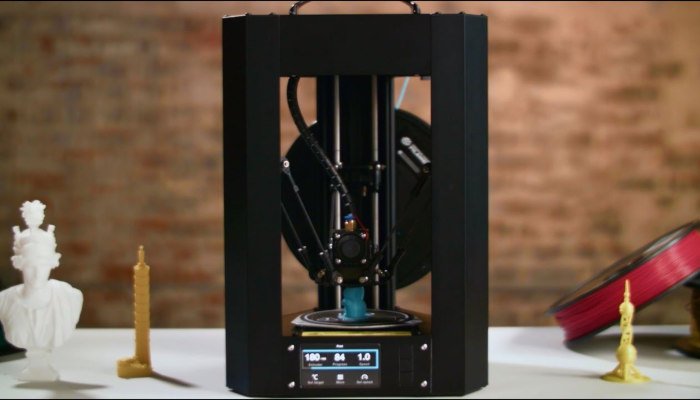
Pros
Great speed and precision.
Comes fully assembled.
The heated bed allows for printing ABS and other trickier filaments.
Cons
Small build area.
The Monoprice Mini Delta is known for being one of the best budget 3D printers around, with great precision (up to 50 microns), speed (up to 150 mm/s) — and it’s open source!
An open source delta 3D printer, this allows for faster print speed, as with less weight on the print head, faster speeds and quicker acceleration can occur without overshooting. Higher print speeds can therefore be maintained without any loss of accuracy, making it one of the best fast 3D printers for the price.
Unlike many delta printers, the Monoprice Mini Delta comes fully assembled, so you can get printing in less than an hour from opening the box. The heated bed means you can print ABS and other trickier 3D filaments, and you can print via WiFi as well as by USB or SD card.
The sturdy metal frame improves part print quality by anchoring the printer down so external factors like vibrations don’t impact quality, and overall it’s a fantastic open source 3D printer for a low price.
Anet A8 – Low cost open source 3D printer
- Price: $180 — Available on Amazon here
- Size: 220 x 220 x 240 mm
- Minimum layer thickness: 100 microns
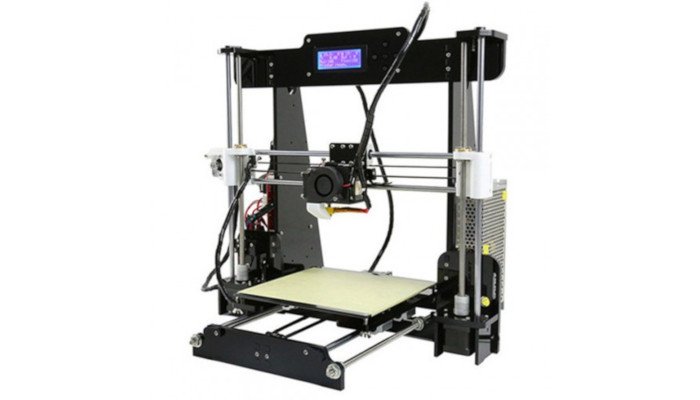
Pros
Versatile allowing to process of multiple filaments.
Reliable and accurate.
Fairly large.
Cons
There are better quality options for similar prices.
Will take a few hours to build as it comes as a kit.
A low-cost open source 3D printer, the Anet A8 is a 3D printer kit that you will have to build yourself. It will take a few hours (up to six, actually), but once it’s up and running, not only will you be able to print magnificent 3D models, but you’ll also feel accomplished and appreciate it more having built it yourself.
Since it requires some tech know-how, this may not be the ideal 3D printer for beginners. But for those with enough experience to handle any issues and who can modify their open source 3D printer based on what they want to print, it’s fantastic for such a low price.
Once it’s up and running, it’s a fairly large 3D printer, able to print 220 x 220 x 240 mm parts without issue. It can print standard PLA and ABS, as well as wood-filled filaments and others including Nylon.
Overall, it’s reasonably reliable, accurate, and does everything you could possibly expect for such an affordable 3D printer. And with the open source firmware, you can unleash your creativity and change anything you want to improve.
Creality Ender 3 V2 (and V2 Neo)
- Price: $280 / $300
- Build Volume: 220 x 220 x 250 mm / 220 x 220 x 250 mm
- Print Speed: 180 mm per second / 180 mm per second
- Assembly Time: 30 – 60 minutes / 30 – 60 minutes
- Open Source Rating: Partially open source
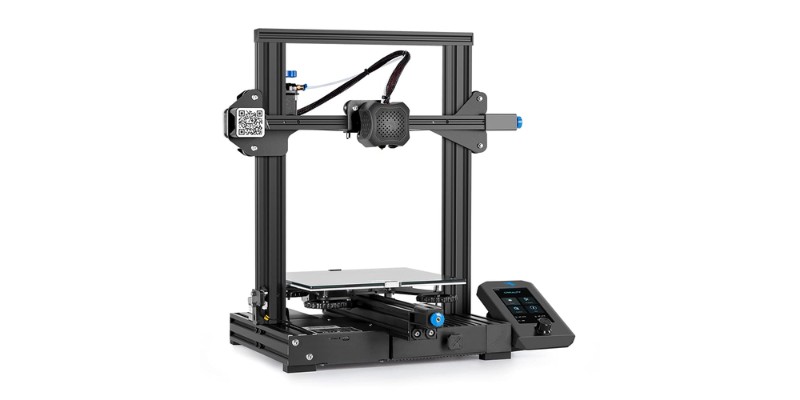
Pros
Budget-friendly
Huge community for upgrade and modding support
Similar designs between the Ender 3, Ender 3 V2, Ender 3 V2 Neo, and Ender 3 Pro allow for more open sourcing
Cons
Noisy
No auto bed-leveling
Limited filament compatibility
The Ender 3 V2 is not technically open source itself – it’s the original Ender 3’s designs that are available.
Still, with the V2 being nothing but an upgraded version of the original, you shouldn’t have any trouble when using the Ender 3’s designs for the V2.
Actually, the same goes for the Ender 3 V2 Neo, as it uses the same general frame style and Bowden extruder as the Ender 3 V2. We recently tested the Ender 3 V2 Neo at 3DSourced, so you can read that if you’re interested in taking a deeper dive.
You’ll notice there are some differences that make it less open source than the V2, but the Creality community’s own documentation and experimentation will help you along the way.
The Neo aside, grabbing an Ender 3 V2 is a great decision if you’re the tinkering type. It’s easy to modify and has decent specs, with a build volume of 220 x 220 x 250 mm and a max extruder temperature of 260°C. You can’t use any really fancy materials, but you can work with PLA, ABS, and PETG with no problem.
It has no auto bed leveling and no touchscreen, which could be some nice first upgrades.
Prusa i3 — best open source 3D printer under $1,000
- Price: $749 as a kit — Available on Prusa store here / $999 fully assembled — Available on Prusa store here
- Build volume: 250 x 210 x 200 mm
- Precision: 50 microns
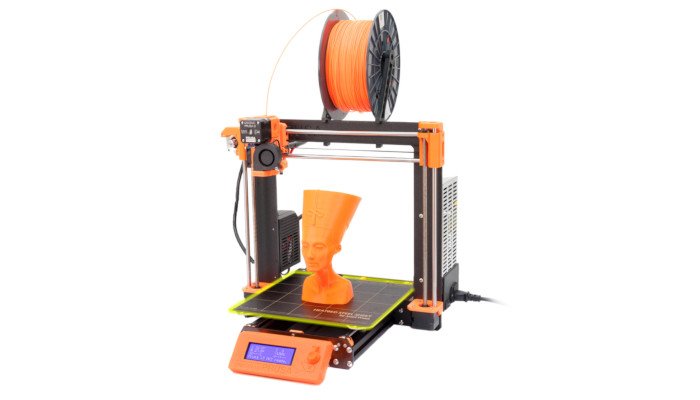
Pros
Reliable and durable, as are all Prusa printers.
Can be upgraded with an MMU kit to print 5 colors of filament at once.
Come with auto leveling and many other great features to save time.
Cons
Can take a long time to build, if bought as a kit.
Whereas some desktop 3D printer brands have turned their backs on open source, Prusa is still committed to the open source 3D printer philosophy, and you can access everything you need on their GitHub.
Known as one of the best 3D printer kits ever made, Prusa 3D printers have won boatloads of awards. Solid printing speed, accuracy, great reliability and compatibility with a variety of filaments (especially with the Multi-Material 2.0 upgrade) make it competitive with printers costing far more.
Designed to save you hassle and time, the Prusa i3 printers will save your current progress in the event of a power outage so you can resume where you left off, it will pause in the event of filament running out so the print doesn’t fail, and can even detect when the filament is clogging. Overall, it’s a fantastic open source 3D printer and we highly recommend it.
Professional Open Source 3D Printers
Prusa SL1S
- Price: $1,999
- Build Volume: 127 x 80 x 150 mm
- Print Speed: 1.4s per layer
- Assembly Time: 5-10 minutes (fully assembled)
- Open Source Rating: Partially open source
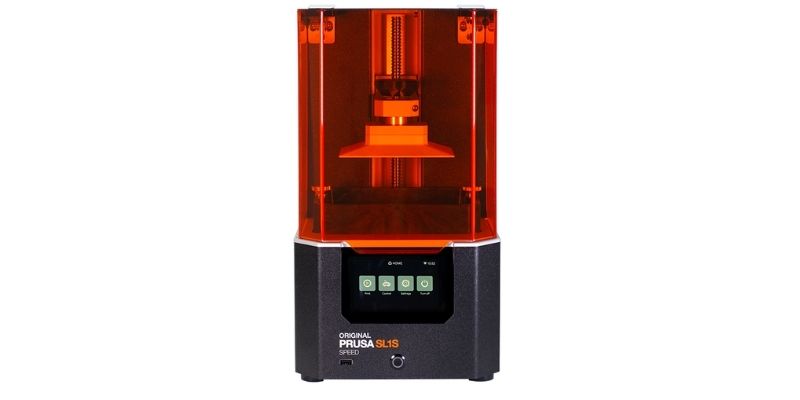
Pros
Resin printing means high-resolution models
Prusa is well-known for their commitment to open-source ideology
Uses non-proprietary resin tank and FEP films
High speed printing
Cons
High price
Small build volume
SL1S is not yet released as open source, so you would need to reference the older SL1
The original Prusa SL1, despite being completely open source, is no longer available for purchase, having been superseded by the Prusa SL1S. We expect that Prusa will release the files of the SL1S soon however, as they always do.
But for now, the SL1S and SL1 are in open-source limbo where only the out-of-production earlier version’s files are currently available on GitHub. Still, we’ll cover the SL1S here since it will be open source in the future, and any shared design aspects are open source.
The SL1S is an expensive but incredibly fast open-source SLA printer. It has a 1.4-second exposure time per layer, meaning it can print a 150mm tall object in just three hours.
The SL1S has a decent LCD resolution of 2560 x 1620p and a 5.96” screen, allowing it to print even the smallest miniatures with good detail. It’s an interesting combination of innovative design choices – like a motorized tilting bed that offers faster and more stable printing – and non-proprietary tech like its resin tank and FEP films.
Truly, it’s a typical Prusa open-source printer through and through.
BCN3D Sigma D25
- Price: $3,995 — Available on Dynamism Store here / Available on Matterhackers here
- Build volume: 420 x 300 x 200 mm
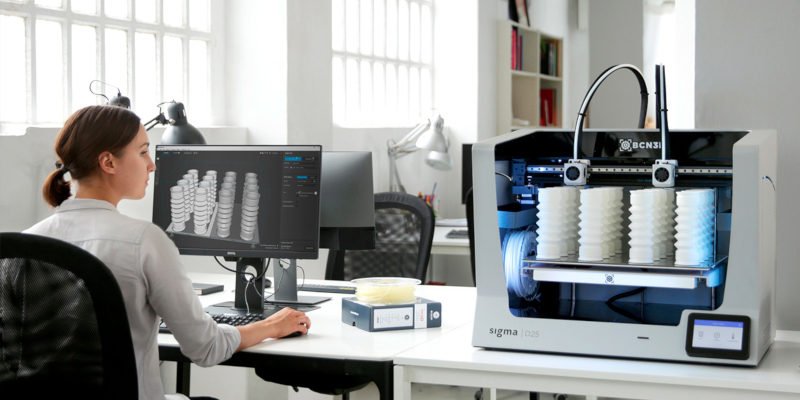
Pros
Comes with an IDEX dual extruder for multi-material, multi-color, or duplicate print options.
Very reliable.
Cons
It is large, but there are larger options available.
Barcelona, Spain-based BCN3D remain committed to open source 3D printing since their inception in 2012. All their printers have open source 3D printer files for firmware, process, software, and more published on the BCN3D GitHub.
BCN3D printers are known for their reliability, and the Sigma D25, their newest printer, is no different. Featuring their signature IDEX dual extruder system which can print in two special modes, Mirror and Duplication, each extruder can function separately, as either a multi color 3D printer, or for printing with a soluble filament for supports that can be easily removed.
Whereas the Sigmax R19 has a completely closed, enclosed build chamber, the Sigma D25 is semi-open. It’s easy to use, reliable, durable with its high-quality stainless steel frame, and prints very consistently and accurately at up to 50-micron layer heights on E3D hot ends. D25 models now have access to WiFi 3D printing, and can automatically install new firmware updates to keep your printer up to date.
Any keen makers or small businesses looking to print fun projects or accurate plastic prototypes, that is also open source, may find the Sigma D25 the perfect 3D printer for you.
Ultimaker 3 / S3
- Price: $4,080 — Available on Dynamism Store here / Available on Matterhackers here
- Build volume: 215 x 215 x 210 mm
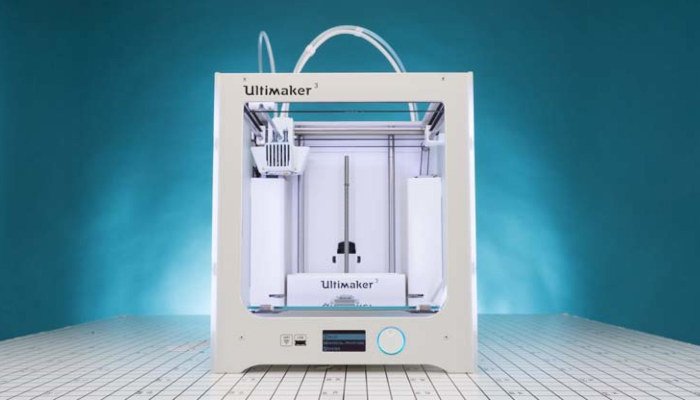
Pros
20-micron minimum layer height makes it very precise.
IDEX dual extruder, allowing to print two materials in one job.
Cons
Lack of speed for the price.
12 months after the Ultimaker 3’s release, the Dutch company released the hardware source files for both the Ultimaker 3 and Ultimaker 3 Extended here. This was no surprise; Ultimaker had previously released the files to other printers including the Ultimaker 2 Go, leading to innovation breakthroughs such as the Olsson Block. Ultimaker also develops Cura, the popular and open source 3D slicer.
Known as one of the best 3D printers of its generation, the Ultimaker 3 is incredibly accurate and widely adopted for rapid prototyping precise plastic parts. It comes fully assembled and almost ready to print; you can get it all started within just a few minutes.
It works with Ultimaker’s open source 3D printer software, Cura, and features a built-in camera for monitoring your print’s progress remotely. It’s not the fastest, but prints with flawless accuracy for an FDM 3D printer, and the dual extruder also adds to its offering.
Ultimaker has not yet (as of August 2021) released any source files for the Ultimaker S5 or S3, but some of the parts are near identical to the Ultimaker 3.
List of other open source 3D printers (with purchase links):
There are also a range of other open source CNC machines beyond 3D printers, ranging from the MPCNC (mostly printed CNC), to the original ShapeOko designs (before they became closed source with the Shapeoko 3 and 4). If you’re looking for a 3D printer that can also CNC and laser cut, we also have an article on the best all-in-one 3D printers.
Where can you download open source 3D printer designs?
Depending on the company, open-source 3D printer designs are usually stored on GitHub, the RepRap wiki, or even Google Drive. You can find links to the source files on the company’s website in some cases, too.
- The Prusa i3’s designs can be found on GitHub and in Prusa Research’s guide
- The Ultimaker 3’s designs can be found on GitHub
- The Anet A8’s designs can be found in Anet’s Google Drive
- The Creality CR-10’s designs can be found on GitHub
- The Creality Ender 3’s designs can be found on GitHub
- The Snappy 3’s designs can be found on GitHub through the RepRap Wiki
How open source can improve 3D printers: Olsson Block
By letting anyone build on the design, features, or firmware of a 3D printer, new developments can occur beyond what the manufacturer builds.
An example of this is the development of the Olsson Block by Anders Olsson.

Anders used his experience as a research engineer to experiment with an open-source Ultimaker 3D printer, attempting to make printing boron carbide possible.
He succeeded– but at the cost of the nozzle, which was worn away after just one print.
So, Anders designed a block (now dubbed the Olsson Block) that allows for quick-swapping nozzles. The block was welcomed with open arms by the Ultimaker community, who recognized its value for a variety of applications.

Olsson Blocks are now used by thousands of 3D printers to reduce nozzle switching time. Without Ultimaker’s decision to make their printers open source, this important invention may not have been developed.
Open Source vs Closed Source 3D Printers
Makerbot, Printrbot, Lulzbot (by Aleph Objects), Ultimaker, BCN3D and several other 3D printer companies were formed championing the open source 3D printer movement.
However, some have since struggled.
Printrbot closed down in July 2018 citing low sales, while Lulzbot laid off the majority of their staff in October 2019, facing closure before they were rescued and bought out.
Makerbot, perhaps the most successful 3D printer company to emerge from the DIY 3D printer revolution, famously turned their back on the open source philosophy, and now their 3D printers are closed source and IP-protected. The company was acquired for $400M by Stratasys.
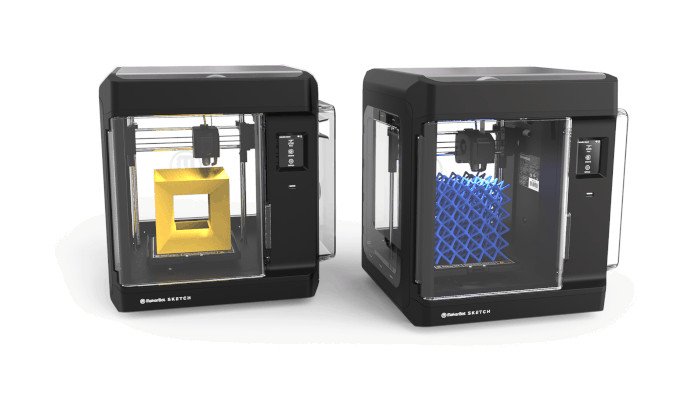
However, some open-source 3D printer companies continue to show strong growth and prove that open source is not only well-loved, but also a profitable strategy.
BCN3D continue to produce high-quality printers, including the Sigma D25 and Epsilon, while Ultimaker have grown to become one of the most respected 3D printer companies in the world. Not to mention Prusa, who stayed committed to open-source 3D printing while becoming one of the top-performing 3D printer manufacturers.
FAQs
Are Creality 3D printers open source?
The Ender 3 is the only truly open-source Creality 3D printer, and its designs are available for download on Creality’s GitHub. However, most Ender printers, like the Ender 3 V2, V2 Neo, and Ender Pro, reuse enough elements from the original Ender 3 to be considered open source, and you’ll have no issue tinkering with them.
Is Ender 3 Pro open source?
The Ender 3 Pro isn’t technically open source, but it’s similar enough to the original Ender 3 to be considered open source. It keeps the same basic hardware and design while making mostly superficial upgrades. That means you can use the Ender 3’s designs, which are available on GitHub, for your Ender 3 Pro.
Is Ender 3 V2 Neo open source?
The Ender 3 V2 Neo isn’t open-source itself. However, it’s nearly identical in basic hardware and design to the Ender 3, with the files available on GitHub. That means the V2 Neo is functionally open source, just not technically open source. You can use the original Ender 3’s designs as a reference while working on the V2 Neo.
Is Cura open source?
Cura is an open source slicer for 3D printing, which means its source code is available for anyone to tweak on GitHub. It was initially developed by Ultimaker, a 3D printing company known for supporting open source designs. Additionally, Cura is already a free slicer which makes it even more accessible to the community.
Is Voxelab open source?
Not all Voxelab printers are open source, but the Aquila series (including the Aquila X2 and Aquila S2) are open source and therefore available to the wider public. Voxelab hasn’t expressed much interest in creating more lines of open source printers, leaving the designs of popular models like the Aries a secret.
Is Flashforge open source?
Flashforge printers aren’t really open source, although they advertise the Creator series as being founded on open source technology. None of the designs for their printers are readily available on GitHub or other repositories, which is the main requirement for a printer to count as open source. However, Flashforge printers can usually interface with open source software like Cura.
Are Prusa 3D printers open source?
Prusa 3D printers are all open source, since Prusa as a company is committed to the ideal of open source innovation. The Prusa i3 is one of the most popular RepRap (open source) 3D printer designs out there, and creator Josef Prusa has continued to release open source printers from the SL1 to the MK4.
Other articles you may be interested in:







